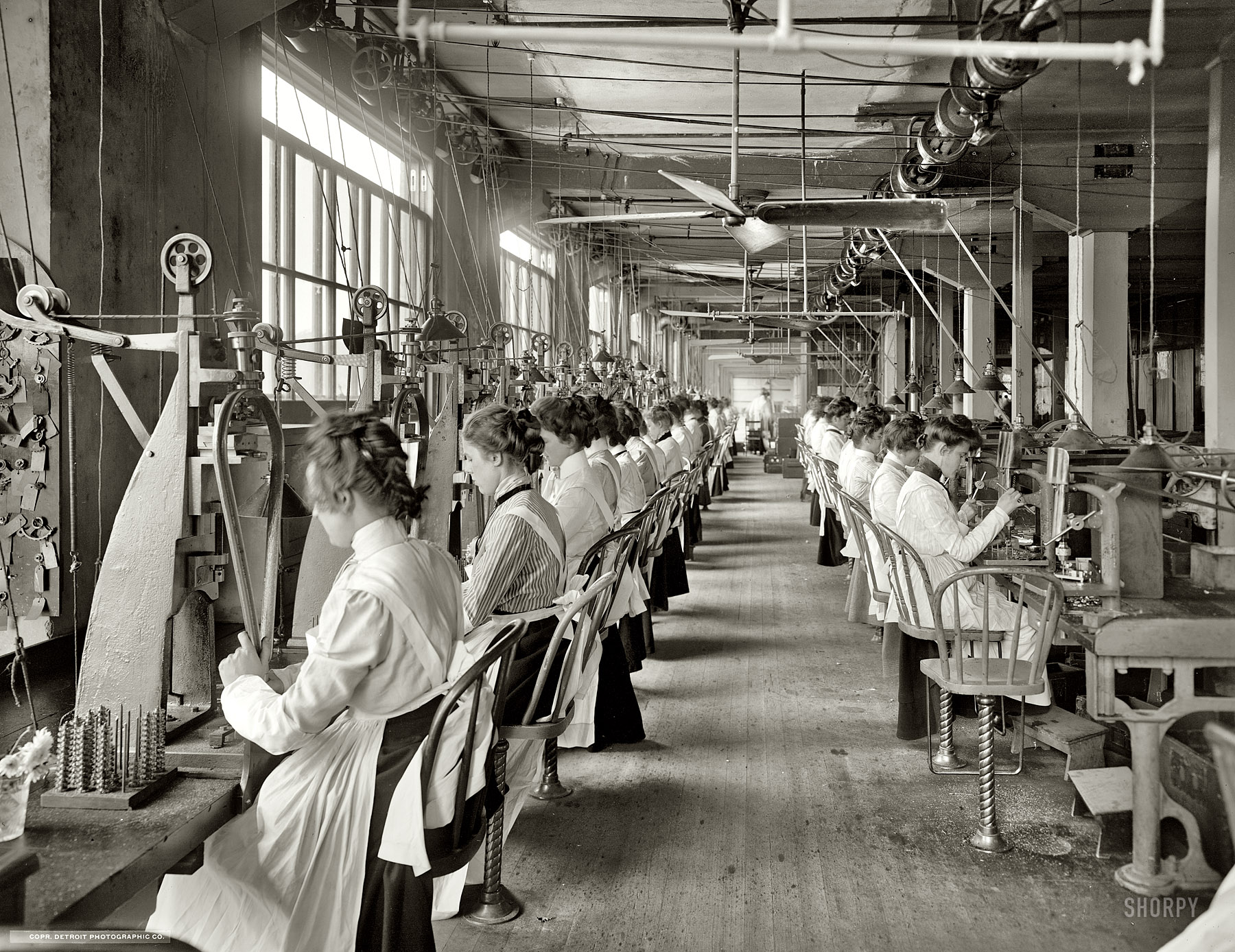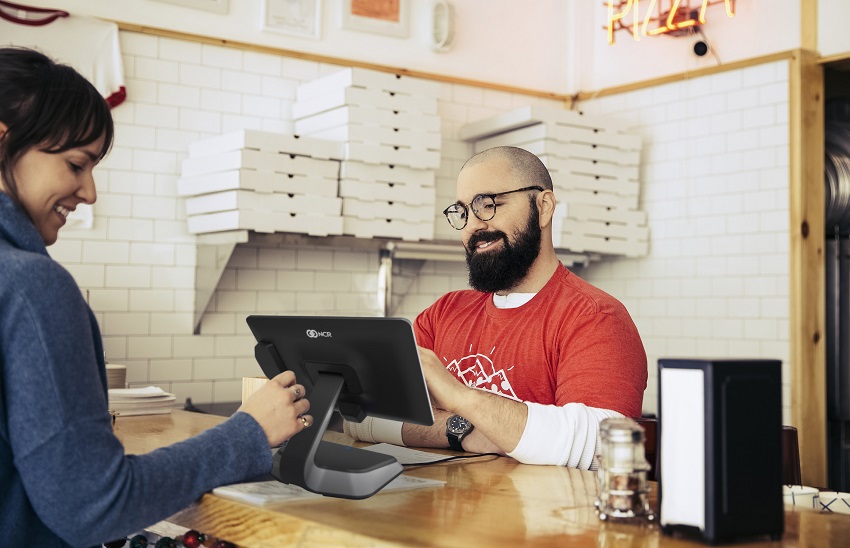The dawn of sales and marketing.

The first cashier
On November 4th, James Ritty patents “Ritty’s Incorruptable Cashier Machine”.
NCR is born
A group of investors acquires Ritty’s cash register, company and patents. The new owners establish National Manufacturing Company.

A new name
John H. Patterson , who was previously in coal and railroad business, becomes majority owner in the National Manufacturing Company, and renames it to the National Cash Register Company, maker of the first mechanical cash registers. The first office, with 13 employees, is located in the Callahan Power Building, in Dayton, Ohio.

NCR exhibits the self-adding register
Visiting from England, J. W. Allison observes the self-adding cash register at a Chicago exhibition. He learns that the machine can be adapted for English currency. Impressed, he becomes NCR’s first international agent, based in Liverpool, England.

Patterson pioneers the first modern advertising methods.
"Sales make news. And news of sales makes more sales. "Patterson was the first to invent guaranteed sales territories, quota and point systems, sales conventions and dress codes for salesmen. Patterson also invents direct mail, advertising and a sales publication for agents, customers and employees. His campaign, “Get a Receipt,” sells the world on the need to get a receipt with every cash transaction.

NCR prints the world’s first sales manual
It's a 450-word Primer based on the successful sales presentations of his brother-in-law, Joseph H. Crane. Formal sales training classes are later established. The first employee newsletter, THE NCR, is published.

The daylight factory is invented
Patterson constructs first “daylight factory” buildings with floor-to-ceiling glass windows that could be opened to let in fresh air, improving lighting and ventilation for employees.
.jpg)
Employee benefit programs
NCR begins offering hot lunches, a “glass” factory to improve lighting and ventilation, baths, showers, exercise programs, social and professional clubs, and many more—including an onsite doctor, which we still offer today.
NCR ramps up production.

Canvas University makes camp
A tent camp is set up in Sugar Camp at Dayton, Ohio (the former seat of NCR) to train sales persons, who call it “Canvas University.”
.png)
The first electric powered register
Charles F. Kettering designs the first cash register powered by an electric motor. Within a few years, he will develop the Class 1000 register which will be in production for 40 years. Kettering also develops the O. K. Telephone Credit Authorization system for verifying credit in department stores.
The Class 500 in a class of its own
The Class 500 was the most complex and ornate register manufactured by NCR during this time period. It could keep track of up to nine separate totals, which meant that it could be used by nine different clerks or keep track of nine separate departments at the same time. The 1909 National Cash Register Catalog describes it as follows: “Class 500 registers are furnished with five rows of keys; registering capacity, 1 cent to $99.99 and one row of special keys, and with six rows of keys, registering capacity, 1 cent to $999.99, and one row of special keys.
One Million Registers
The One millionth cash register is sold in NCR’s 27th year of business.
.jpg)
Relief during Dayton's great flood
NCR saves many lives during the great flood in Dayton. John Patterson orders flat-bottom boats made by company carpenters; a tent city is erected for the homeless; and food and medical care are dispensed. Patterson successfully heads a million-dollar relief fund.
NCR enters banking
NCR begins manufacturing the Class 2000 accounting machines. Marketed in different versions up until 1973, the 2000 is the longest-running and one of the most successful of any NCR product. Different models will be constructed for accounting, banking, payroll and hotel administration. CEO: Frederick Beck Patterson, John Patterson’s son, becomes President, and his father the Chairman.
A new bank machine
NCR introduces the Class 2000 bank machine, in an electronic version called the Postron-ic. It has over 20,000 parts and is assembled by hand. John Patterson, founder of NCR, dies after having led the company since 1884.
NCR makes a shrewd acquisition
NCR buys the Ellis Adding Typewriter Company that produces the only machine available that combined a typewriter with an adding machine in one unit. This makes detailed accounting reports possible for the first time. NCR will improve on the concept until it is the most flexible accounting machine to exist in pre-electronic era.
NCR pioneers computing and automation.
Colonel Edward A. Deeds returns to NCR to become Chairman of the Board.
Colonel Edward A. Deeds returns to NCR to become Chairman of the Board. He also co-founds the Wright Airplane Company with Orville Wright and others.
NCR takes part in the war efforts during WWII.
An NCR research team, led by Joseph R. Desch, breaks the German Enigma Code.
NCR enters computing
NCR acquires the Computer Research Corporation (CRC), which produces a line of digital computers with applications in aviation.

The Post-Tronic in unviled
NCR’s Post-Tronic, the first product with automated features, is introduced to the banking industry.
A new chairman
Stanley C. Allyn becomes Chairman of the Board.
Solid state processors
NCR introduces the NCR 304 business computer. It’s the first commercially available computer with a solid-state processor.
NCR goes digital.
General business computing
NCR develops the NCR 315, a general-purpose business computer. It is the first computer with the ability to upgrade to a higher version in this series.The NCR 390 is the first low-cost, mass-marketed computer. It uses punched tape recorders for original data entry.
Optical scanning
The 420 optical scanner system is introduced. It reads the entered data from cash register journals and accounting machine tapes. The NCR 315 computer with random-access memory, and later, all-thin-film rod memory, is introduced.
Robert S. Oelman becomes Chairman of the Board.
He oversees the switch from traditional to electronic cash registers.
The NCR 615 Century series is introduced.
It is the first low-cost electronic data processing system to put programs, operating software and data on a hard disk.
William S. Anderson is named Chief Executive Officer.
The 10-millionth machine, the NCR 280, is manufactured.
The NCR company changes its name to NCR Corporation.
NCR commercializes bar code scanners. The world’s first Universal Product Code (UPC) scanner is installed at Marsh’s Supermarket in Troy, Ohio. The first item to be scanned is a package of Wrigley’s Juicy Fruit chewing gum.

NCR develops Automated Teller Machines
That marks the beginning of electronic funds transfer. Later, the development of NCR drive-through ATMs revolutionizes banking convenience for customers.
NCR acquires Com-ten
NCR becomes a leader in data communication technology with the acquisition of Com-ten, Inc., a data communications technology provider.
The first NCR Tower super microcomputer system is launched.
This establishes NCR as a pioneer in bringing industry standards and open systems architecture to the computer market.
Charles E. Exley, Jr. is named Chief Executive Officer.
He oversees the release of NCR’s first personal computer and the company’s development of ATMs that introduced features that became standard in the industry. NCR 9300, the industry’s first 32-bit VLSI mainframe, is released.
NCR forms a Personal Computer Division is formed.
Several new, industry-compatible personal computer models are introduced. A 32-bit model is added to the UNIX®-based NCR TOWER family. A new generation of self-service automated teller machines is introduced.

Value through products
A company-wide program makes NCR people aware of the company’s mission to “create value for stakeholders.” Product introductions include a new generation of advanced point-of-sale systems for the retail industry and a comprehensive new family of personal computer products.
NCR expands through acquisitions.
NCR is acquired by AT&T—with resistance from NCR itself.
AT&T and NCR sign a definitive merger agreement in May, and the merger completed on September 19. Product introductions include NCR’s fourth-generation of ATM technology, which offers retail banks an unprecedented level of availability: up to 99.9 percent. Gilbert P. Williamson named Chairman and Chief Executive Officer.
NCR purchases Compris Technologies, Inc.
Compris Technologies, Inc. was a leading provider of store automation and management software for the food-service industry. It also purchases Dataworks, a company that develops check-processing software, to grow its global imaging and item processing business. NCR prototypes the NCR self-checkouts
Mark Hurd appointed Chief Executive Officer of NCR.
NCR acquires Kinetics, a leading provider of self-service check-in.
Bill Nuti joins NCR as Chairman and Chief Executive Officer
He begins reinventing the iconic company.
NCR announces a spinoff of Teradata
Teradata was the company’s data-warehousing business.
NCR acquires NetKey to provide end-to-end kiosk and digital signage solutions.
The company opens the Innovation Hub and manufacturing facility in Manaus, Brazil, and the Services Center of Excellence in Peachtree City, Georgia. NCR moves global Corporate HQ from Dayton, Ohio to Duluth, Georgia.
NCR goes all in.
Welcome to the world, omni-channel! A world where physical and digital boundaries begin to blur for the ultimate customer experience.
We’re talking mobile apps for anytime, anywhere interactions between people and their favorite brands. Plus mobile barcode scanning, beacon technologies and ATMs that have live teller access even after the bank branch has closed.
We’re NCR. We’ve been around 130+ years. But we’re just getting started.
NCR unveils the world’s first hybrid laser and imaging bi-optic scanner for retail
NCR also introduces a new model of services delivery: Predictive Services that helps fix assisted and self-services devices before they fail. Radiant Systems, developer of the Aloha POS, is acquired.
NCR acquires Retalix.
Retalix was a provider of retail software and services.
NCR acquires Digital Insight Corporation
That enables NCR to enter Digital Banking.
NCR announces Global Headquarters
NCR partners with Georgia State and City of Atlanta and announces the development of the Global Headquarters Campus and $450 million public – private investment in Midtown Atlanta.
In April, Mike Hayford is named CEO of NCR Corporation.
He leads the company’s strategic shift from hardware provider to a software- and services-led enterprise technology partner that helps banks, stores and restaurants run their operations. Also, NCR opens its 750,000 square feet state-of-the art Campus to its employees.
NCR acquires JetPay
That marks its entry into end-to-end payments processing for customers. NCR also acquires StopLift, to prevent self-checkout fraud, and ZipScene, a data analytics provider.
NCR announces Belgrade campus
The new campus will be a hub for Digital Connected Services. NCR acquires D3 Banking Technology to provide digital banking solutions for large financial institutions.


